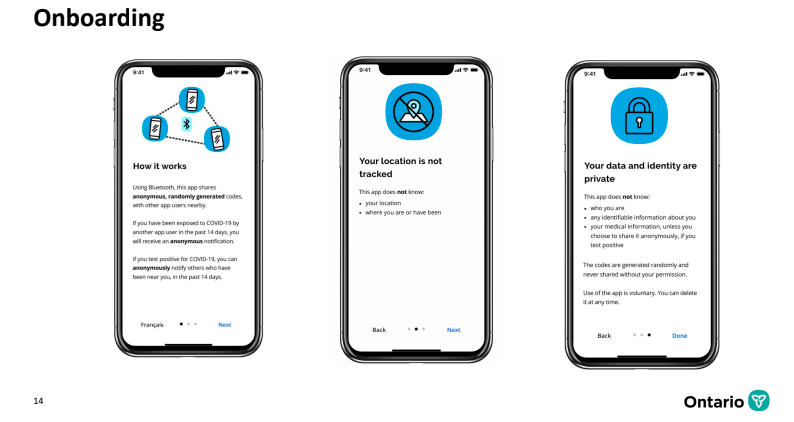Ontario is launching a mobile app to help track cases of COVID-19, the premier announced Thursday, and the province is replacing outdated public health systems to boost its ability to contain the spread of the virus as more regions reopen.
The app, named COVID Alert, is expected to launch July 2 and will supplement the province’s contact tracing strategy, Doug Ford said.
“We face an invisible enemy, but if we test we can find it,” Ford said at a news conference. “If we trace, we can track it. And if we have those two things, we can contain it.”
The app is voluntary, and will notify users based on a number of criteria, including if they were within two metres of a person who tests positive for the virus and if that contact was over an extended period of time.
Early detection is critical, said Health Minister Christine Elliott.
“As we begin to reopen the province, the number of contacts per case is expected to increase,” she said, noting more regions will enter Stage 2 of the reopening plan on Friday.
“As they do, it’s never been more important to ensure that Ontarians and public health units have the additional resources, tools and support they need to keep themselves and their communities safe.”
The app is being rolled out in Ontario first, but Prime Minister Justin Trudeau said Thursday it should be ready for downloading across the country this summer.
It was developed by the Ontario Digital Service and Shopify, with input from the Information and Privacy Commissioner.
Privacy was the No. 1 priority, Ford said as he urged Ontarians to download it.
“If we don’t have co-operation of the people of Ontario we put ourselves more at risk,” he said. “It’s going to protect us. It’s going to protect your families.”
Privacy commissioner Brian Beamish said he is satisfied privacy is being “properly considered and addressed,” though that’s subject to review since he hasn’t yet seen the app in its final form.
The app uses Bluetooth to share anonymous, randomly generated codes with other app users nearby, and does not track or store personal information or location data, officials said. The anonymized information is destroyed after 14 days.
If a person tests positive for the virus, a user can choose to anonymously notify others they have been near over the previous two weeks.
Ontario’s chief medical officer of health, Dr. David Williams, said the app could also help prevent future long-term care outbreaks, with staff who may be unaware they were infected being notified sooner and not bringing it into the home.
The province is watching data from a contact tracing app Alberta is using, Williams said. Out of that province’s 4.3 million people, 207,000 use the app.
Meanwhile, Ontario also plans to launch a new, $20-million cloud-based case management system this summer.
The change will streamline a system that is over 15 years old and still relies on multiple points of data entry and fax machines to transmit information, Elliott said.
“Right now our laboratory system isn’t working with our public health system,” Elliott said.
“We need to connect the two of them so that information can come forward immediately, so you don’t have to rely on faxes anymore — which sadly are still around in health care.”
The province also said Thursday it will bolster its contact tracing work force — doubling its current capacity to more than 4,000 workers. Ontario’s current pool of 1,500 to 2,000 contract tracers will be expanded by adding 1,700 workers from Statistics Canada and as many as 600 workers who could be redeployed from within Ontario’s public service.
Ontario reported 173 new cases of COVID-19 Thursday, and three more deaths. It’s the lowest number of new cases since late March and brings the province to a total of 32,917.
The total includes 2,553 deaths and 28,004 resolved cases, which now make up more than 85 per cent of the province’s total.
The numbers of patients with COVID-19 in hospital, in intensive care and on ventilators all dropped to their lowest levels since the province started publicly reporting those figures at the beginning of April.
Sudbury’s health unit reported its first two positive COVID-19 cases since May 14, with the medical officer of health for the region calling it a “reality check.”
“We are not clear of the virus yet,” Dr. Penny Sutcliffe said in a statement. “With the reopening of the province, we have more opportunities to interact with each other and for the virus to spread.”
The province said it will begin to gradually reopen driver testing centres beginning Monday, and expects to fully restore service by September.
The centres will begin serving customers based on when they were born to respect physical distancing and reduce crowding. People with birthdays between January and June can visit a centre in the first week of reopening. People with birthdays between July and December can access the centres during the second week.
Education Minister Stephen Lecce, who is expected to announce a plan soon for September’s return to school, said Thursday the province is spending $15 million for thousands of classroom computers and $10 million to hire additional mental health workers for students.
— This is a corrected story. A previous version, based on a government briefing, had an incorrect name for the app.
This report by The Canadian Press was first published June 18, 2020.
Allison Jones and Shawn Jeffords, The Canadian Press









